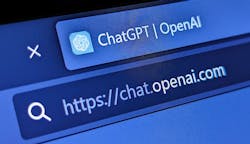Inductive Automation Encourages Experimentation with ChatGPT
We’ve all been hearing how much ChatGPT and large language models (LLMs) in general are going to impact numerous aspects of nearly every industry—and the automation industry is certainly no exception. Even though we’re only in the very early stages of ChatGPT experimentation (the technology was publicly released less than a year ago), we’re already beginning to separate some of the reality from the initial hype—and that’s helping lead to learning more about its true value in industry applications.
To help advance industry’s understanding of what ChatGPT can do in the industrial automation realm, Inductive Automation (supplier of the Ignition platform often used for HMI, SCADA, IIoT, alarming and reporting applications) has been encouraging Ignition partners and users to share their experience using ChatGPT to handle various programming tasks with Ignition.
Corso Systems, an Inductive Automation premier integrator, conducted a project that involved supplying ChatGPT-4 with the information needed to create a basic data entry form. Having achieved success with this project, they then asked ChatGPT to provide detailed instructions on how to create a Perspective view, add components to the view, and publish the project. Perspective is an Ignition module for building mobile-responsive HTML applications. According to Corso Systems, ChatGPT was able to create a script to write data to the database.
While this more advanced experiment with ChatGPT and Perspective proved successful, Corso Systems notes that, to generate this information from scratch with ChatGPT a user would need to know a lot about Perspective views. The company notes that the process “felt like teaching someone who came to the table with some programming experience—but who was brand new to Ignition.”
See more details about Corso Systems work with ChatGPT and Ignition.
Inductive Automation solution partner 4IR Solutions (a supplier of managed hybrid cloud infrastructure) also shared some of its findings based on work with what it calls ChatIGN (ChatGPT in Ignition).
According to Joseph Dolivo, chief technology officer at 4IR Solutions, using the OpenAI Chat API (application programming interface) you can build your own applications with ChatGPT-3.5-turbo and ChatGPT -4 to do things like:
- Write Python code.
- Answer questions about a set of documents.
- Create conversational agents.
- Give your software a natural language interface.
He adds that, “as it exists today, ChatIGN would probably appeal most to integrators, hobbyists, or tech-savvy end users with limited programming experience.”
As for recommendations to those who might be interested in conducting tests with ChatGPT around industrial automation software, Dolivo says, “I would love to see more folks using this resource for inspiration or as a building block for their own applications. Given that the Ignition community is known for its openness and collaboration, I would encourage more Ignition users to share their creations via the Ignition Exchange or even open-source them on communities like GitHub, as companies like Axone-IO and Barry-Wehmiller Design Group have done.”
Dolivo adds that he is most interested in exploring the use of LLMs as a troubleshooting tool by inputting operational data via prompt engineering or fine-tuning the model.
The video below details some of Corso Systems work with ChatGPT and Ignition Perspective.
About the Author
David Greenfield, editor in chief
Editor in Chief

Leaders relevant to this article:

